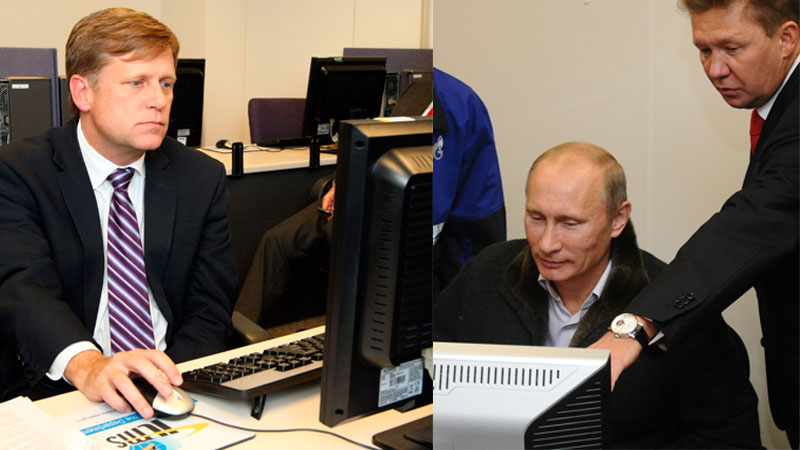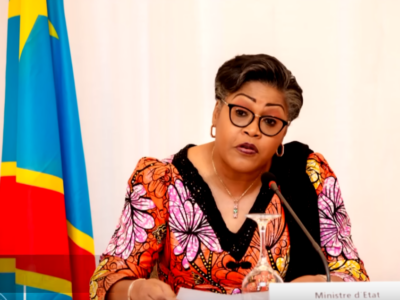
Michael McFaul, left, and Vladimir Putin, right. Images edited by Kevin Rothrock.
As US ambassador to Russia, Michael McFaul made quite a splash online. During his two-year stint as America's top man in Moscow, McFaul regularly tweeted, posted to Facebook, and blogged on LiveJournal.
McFaul's commentary spanned both his professional and personal life, and he was not afraid to engage with his online audience, even when that meant fighting a “Twitter war” with the Russian Ministry of Foreign Affairs or discussing his personal life and American culture with followers from Siberia.
In many ways, McFaul became a poster boy for Secretary of State Hillary Clinton's push to adapt American statecraft to the twenty-first century by embracing digital diplomacy. Foreign Policy named McFaul among the “Twitterati 100″ for 2013, Medialogia rated him the tenth-most-quoted blogger on the RuNet in 2012, and the State Department's official monthly magazine even ran a cover story on his social media activities in December 2013.
In February 2014, however, McFaul resigned his post amid worsening US-Russia relations, and returned to teach and study at Stanford. To take his place, Washington sent John Tefft, a career diplomat who previously served as US Ambassador to Ukraine, Georgia, and Lithuania.
Following Tefft's arrival in Moscow in September 2014, Spaso House‘s online presence has changed to reflect its new boss. In a sharp departure from McFaul, Ambassador Tefft has no personal Twitter or Facebook accounts.
Instead, the embassy is now foremost represented on these social media platforms by standard organization accounts: @USEmbRu on Twitter and the US Embassy Moscow page on Facebook. Both of these accounts post content regularly, favoring more formal diplomatic-outreach messaging, like the tweet below, and only occasionally engage with followers.
Новогоднее поздравление посла США в России Джона Теффта: http://t.co/6i4F7Jm5PR
— Посольство США в РФ (@USEmbRu) December 31, 2014
New Year's greetings from US Ambassador to Russia John Tefft
Despite the change of tone following McFaul's departure, the US embassy has on occasion displayed flourishes of liveliness, challenging the likes of Konstantin Rykov and Anton Korobkov, two prominent pro-Kremlin bloggers. In December 2014, for instance, @USEmbRu mocked Rykov's decision to block it on Twitter.
Noooooooo! pic.twitter.com/hqGkwHhB0y
— Посольство США в РФ (@USEmbRu) December 16, 2014
Rykov soon changed his mind, which @USEmbRu joked about, too.
Yay! pic.twitter.com/D7NkniOkf3
— Посольство США в РФ (@USEmbRu) December 16, 2014
Also in December, @USEmbRu retweeted several posts (including the one below) lampooning Korobkov's campaign to reinstate his Twitter account, which was banned for posting death threats against a Ukrainian politician. (Ultimately, Twitter acquiesced and returned the account to Korobkov.)
Тот самый момент, когда у тебя 100 000 фолловеров, а тебя вышло поддержать 8 человек, потому что все остальные боты pic.twitter.com/h9uhHKbKOB
— Евроманежка (@euro_manezhka) December 28, 2014
That moment when you have 100,000 subscribers, but only 8 people come out to support you, because everyone else is a bot.
@USEmbRu also does sometimes retweet the more topical political tweets that tend to excite social networks. As would be expected, in recent months these retweets have often been related to events in Ukraine.
Adding to the embassy's Twitter presence is spokesperson @WBStevens, who brings a personal touch, engages more with followers, and posts edgier and more playful political content, such as the tweet below.
На Измайлове. 2,000 рублей ($30). Слов нет. No comment. pic.twitter.com/o5vpcYk7db
— Will Stevens (@WBStevens) January 17, 2015
At Izmailovo [Market]. 2,000 rubles ($30). There are no words. No comment.
Despite channeling McFaul in some ways, @WBStevens only has about 1,500 followers (@McFaul is closing in on 100,000). Stevens is, after all, not Ambassador though.
The embassy updates several other social media accounts, as well, in addition to Twitter and Facebook. The “Embassy Voices” blog on LiveJournal features posts ranging from an embassy intern writing about American football, to promotion of a US pop/rock band touring Russia, to a post by the Vladivostok Consul General reflecting on cities in the twenty-first century. The embassy's VKontakte page largely mirrors its Facebook page. Occasional Instagram posts share photos such as of the beautiful holiday decorations in Spaso House.
Ambassador Tefft does, however, use one social media platform himself. He blogs on LiveJournal.
Since arriving in Moscow in September 2014, Tefft has written ten LiveJournal posts, exhibiting a measured, diplomatic style. In different posts, Tefft tells the story of how he helped bring bronze duck statues to a Moscow park, shares thoughts on the American tradition of Thanksgiving along with his wife's recipe for stuffing, and discusses facing global challenges such as the fight against HIV/AIDS and corruption.
In a post from November, Tefft recounts an outing to the Bolshoi Theater and reflects on how culture and ballet helped build a bridge between the American and Russian peoples during the Cold War, before concluding:
Независимо от того, какие проблемы разделяют наши правительства, я думаю, что русские и американцы едины в своей любви к красоте балета, которая отражает наши общие человеческие переживания языком танца и музыки.
Regardless of what problems divide our governments, I think that Russians and Americans are united in their admiration of the beauty of ballet, which reflects our shared human experiences through the language of dance and music.
Overall, while Spaso House is not neglecting digital diplomacy under Ambassador Tefft, the online buzz generated by Ambassador McFaul in Russia certainly seems to have dissipated in a big way.








1 comment